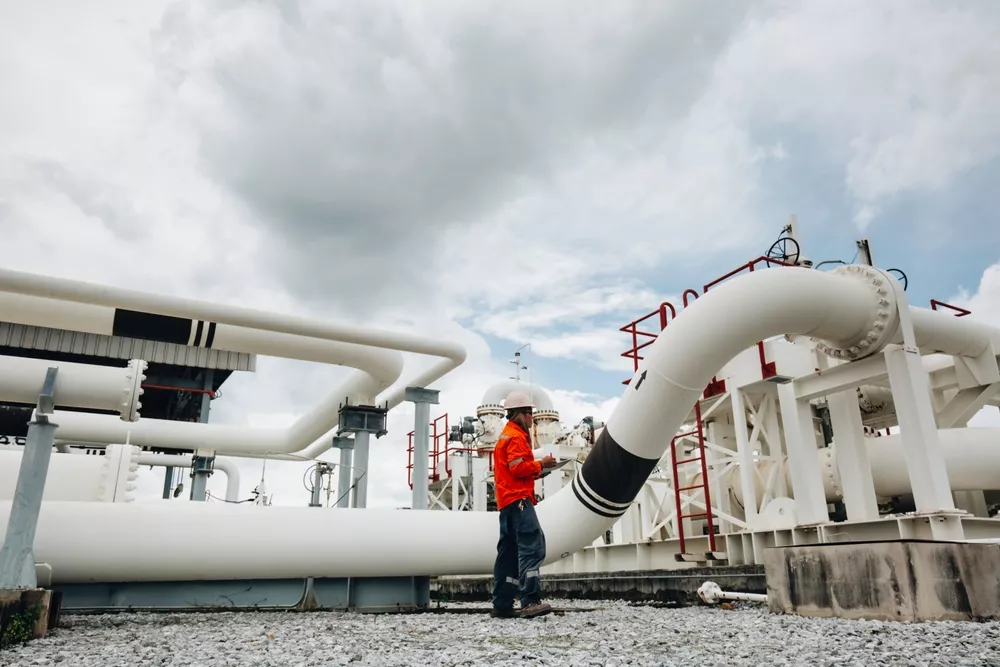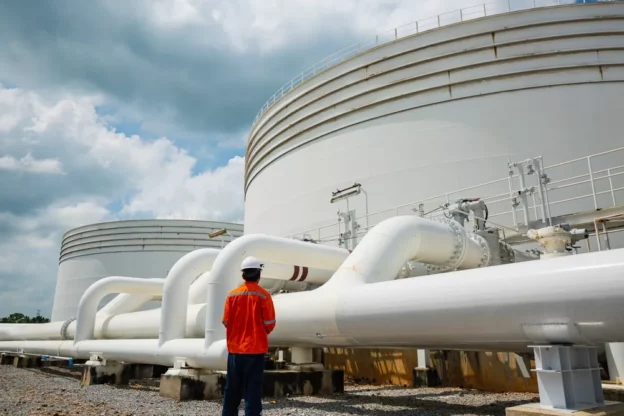Introduction
In the oil and gas industry, the reliability of midstream assets represents a key factor for the optimal development of the operations carried out in this sector. For this reason, good management of the possible risks present in the installations is necessary. To mitigate this issue, a Risk Based Inspection (RBI) can be performed; however, there are several cases in which a reassessment of the RBI may be required.
Inspection of midstream infrastructure and equipment allows for an improved operational experience, as well as providing insight into the condition and development of asset damage mechanisms. However, due to the influence of various factors, a re-evaluation of the inspection process may be required. This article discusses the criteria necessary to carry out a reassessment of the RBI, as well as its influence and importance in the integrity of the midstream sector.
What is the RBI reassessment?

Refers to the systematic and continuous process of reviewing risk assessments and inspection strategies for petroleum industry assets, considering changes in operating conditions1, new data, incidents or modifications to facilities that may affect the integrity and safety of equipment. As a process, it is essential to ensure that the information considered for decision-making on the frequency and type of inspections accurately reflects the current status and risks associated with the assets under study.
The reassessment of the RBI represents a guarantee for the safe and efficient performance of operations, analyzing and optimizing current inspection and maintenance resources, as well as minimizing the risks of failures, accidents or interruptions in the operation, which is critical in the handling and transportation of hydrocarbons and other products within the midstream sector.
Criteria for re-evaluation of RBI
Time-based reassessment
This is a fundamental criterion in the Risk Based Inspection (RBI) methodology for midstream assets. Its approach is based on the periodic process of confirming the impairment rates predicted in the original RBI analysis1, taking into account the passage of time and its impact on the integrity of the asset.
Time is a significant factor in the degradation of assets, which is evidenced in various deterioration mechanisms, such as corrosion, fatigue and cracking, which manifest and evolve over time, affecting the reliability of assets in the midstream sector of the hydrocarbon chain.
The revaluations performed once certain time parameters are met allow adjusting the impairment indexes originally established in the RBI, reflecting more accurately the current condition of the asset and its associated risk.
Event-driven reassessment
The update of the risk assessment for this sector may also be performed due to the occurrence of specific events, as they provide new information relevant to the original risk analysis2. This criterion indicates that re-evaluation of the RBI shall be considered for any significant change or event that may influence the integrity and safe operation of the assets, such as new inspection data, changes in raw materials used, modifications in operating conditions, unexpected equipment failures, or facility upgrades and renovations.
The process of revalidating data from a midstream asset inspection and its mitigation strategies is justified considering the fact that changes generated in the process or hardware can significantly alter equipment conditions and other aspects such as Probability of Failure (PoF) and Consequences of Failure (CoF). For example, an improvement in the quality of the materials of a pipeline system could reduce its PoF, while the relocation of these assets could modify its CoF.
This proactive approach to inspection data reconsideration functions as a resource to ensure safe and efficient hydrocarbon handling and transportation operations, which depend on an accurate and up-to-date understanding of potential operational risks. Event-driven reassessment is carried out in response to unexpected events and changes, allowing organizations to adapt their inspection and maintenance strategies to changing conditions, optimizing integrity management and maintaining high safety standards.
Factors that may cause the revaluation of RBI of midstream assets
Changes in processes and equipment
A number of needs may arise in this sector’s value chain, such as improving operational efficiency, ensuring compliance with environmental or safety regulations, or simply adapting to technological evolution. For this reason, machinery, equipment and operational processes in the midstream sector may undergo modifications or upgrades.
These changes in technology or processes can significantly alter the risks associated with the assets. For example, the introduction of management and monitoring systems can change operating conditions, generating new risks or modifying existing ones. The same happens with equipment changes and upgrades, affecting the rate of deterioration of assets or exposing them to damage mechanisms not previously considered.
To ensure the reliability of midstream assets, a careful and systematic review of the RBI analysis is required so that all possible risks are identified, assessed and properly managed. This can be done in different ways, by developing new risk assessments, defining inspection frequencies, or implementing new control measures to minimize potential risks.
Identification of deterioration mechanisms
One of the objectives of the development of risk-based inspections is to ensure control over the impairment mechanisms that can affect assets. However, although certain degradations may be mitigated, there is a possibility that new deterioration mechanisms may develop that were not previously considered.
For example, in a piping system that transports fluids at high temperature, the discovery of a new decay mechanism such as the Flow Accelerated Corrosion (FAC) could reveal that flow conditions and their chemical composition are affecting the corrosion rate in certain areas of the pipeline that were previously considered low risk.
In cases such as this, it becomes necessary to re-evaluate the RBI immediately, since this process allows adjustments to be made to the inspection and maintenance plans, with the aim of defining preventive and corrective strategies to mitigate possible associated risks.
Implementation of mitigation strategies
After implementing an inspection plan and executing the corresponding mitigation measures, it is imperative to perform a reassessment of the RBI to update the risk levels and reschedule the inspection plan. This reassessment serves not only to verify the effectiveness of the mitigation strategies implemented, but also to adjust midstream asset maintenance and inspection practices.
The re-evaluation process seeks to ensure that the strategies have the expected outcome on the risk to be controlled1. For example, in the case of making improvements to corrosion detection and control systems to reduce the risk associated with pipeline integrity, it would be necessary to subsequently evaluate whether such improvements have effectively decreased the Probability of Failure (PoF) or the potential impact of such failures.
Importance of RBI reassessment
Risk Based Inspection (RBI) reassessments are necessary for optimal asset integrity management in the midstream sector. Carrying out this practice allows maintaining an up-to-date RBI database, which is extremely useful for the dynamic nature of midstream operations, where processes may be subject to continuous change. The RBI methodology, when used strategically, facilitates the continuous improvement of inspection plans, thus optimizing the prevention of failures in critical equipment and reducing the associated risk.
Reassessing the RBI is essential for updating risk analyses3, providing the latest information, and ensuring that maintenance and inspection decisions are increasingly accurate and informed. In addition, it facilitates the verification of the effectiveness of the inspection techniques and improvement strategies previously employed, allowing for their adaptation if necessary.
Conclusions
In order to carry out operations such as the transportation and storage of hydrocarbons, the reliability of midstream assets is essential for the optimal and safe development of the processes involved in this sector. This involves the collection of data from inspections, ensuring the accuracy and consistency of the information, which are fundamental elements for the strategies proposed.
The RBI reassessment represents a way to adapt existing inspection plans to the operational reality of midstream assets, offering a useful approach to effective risk management. Any company that practices this type of reassessment will be able to certify the operational safety, efficiency and sustainability of its operations, demonstrating the importance of having an updated and accurate view of the risks that may affect its assets.
References
- Inspectioneering. (sf). RBI Assessment Planning. Retrieved February 25, 2024 from https://inspectioneering.com/feature/mipi/rbi/4#Reassessments.
- Caserta, M. (2023, June 1). Revalidation, Reassessment, Evergreening, Updating…What the heck am I supposed to do with my RBI program?. Retrieved February 25, 2024 from https://becht.com/becht-blog/entry/revalidation-reassessment-evergreening-updatingwhat-the-heck-am-i-supposed-to-do-with-my-rbi-program/.
- Moreno, D. (2020). Risk Based Inspection. Retrieved February 26, 2024 from https://www.testekndt.net/wp-content/uploads/2020/06/Articulo_Mekinnova_API580_RBI-2.pdf.

